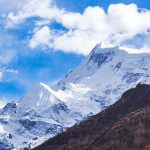How does it feel to be in the Annapurna Circuit in April for trekking?
Picture yourself walking beneath towering snow peaks, through valleys painted with blooming rhododendrons and into villages where prayer wheels spin in the mountain breeze. That is what the Annapurna Circuit Trek in April is like.
Annapurna Circuit is regarded as one of the world’s greatest treks and the circuit loops around the Annapurna mountain range. It covers a total distance of 160 to 230 kilometers, depending on the route you take.
In the 13-day trek of the Annapurna Circuit, you’ll climb from lush subtropical hills to the high, barren landscapes above 5,000 meters, with the dramatic Thorong La Pass (5,416 m) as the ultimate challenge and reward.
What sets April apart in this trek is how alive the trail feels. Winter’s deep cold has lifted, but the summer monsoon hasn’t arrived yet, leaving trekkers with warm days, cool nights and mostly clear skies for jaw-dropping mountain views.

Forests burst into color with rhododendrons and wildflowers, while villages shake off the quiet of winter and welcome trekkers with open lodges, hot meals and lively chatter.
April also adds a cultural spark. Around mid-month, the Nepali New Year (in Baisakh) brings celebrations, rituals and music to towns along the route. This is an unforgettable way to experience local traditions. Trails in April are busier than in winter, yet far more relaxed than the autumn rush.
All these factors make April the perfect balance between solitude and social trekking vibe. Therefore, if you have been waiting for the right time to take on this Himalayan classic, April might just be your golden window.
Highlights
- Trails come alive with rhododendrons and wildflowers, especially around Dharapani and Pisang.
- Warm, stable spring weather makes trekking comfortable and the skies are mostly clear.
- The trails are lively but not overcrowded — easy to find both company and quiet.
- Mid-April brings Nepali New Year celebrations with music, dancing and feasts in the villages of Annapurna Circuit.
- Crossing Thorong La Pass is safer in April as the snow and ice start to melt.
- You’ll walk through everything from green valleys to high alpine meadows and dry plateaus.
- Wildlife is more active — look out for monkeys, Himalayan tahr and colorful mountain birds.
- All the teahouses are open again, serving hot dal bhat, apple pie and warm beds.
- Sacred sites like Muktinath feel even more special with the spring festival energy.
- Aside from some afternoon winds or the odd shower, the conditions are very manageable.
Why April is Perfect for Annapurna Circuit Trek
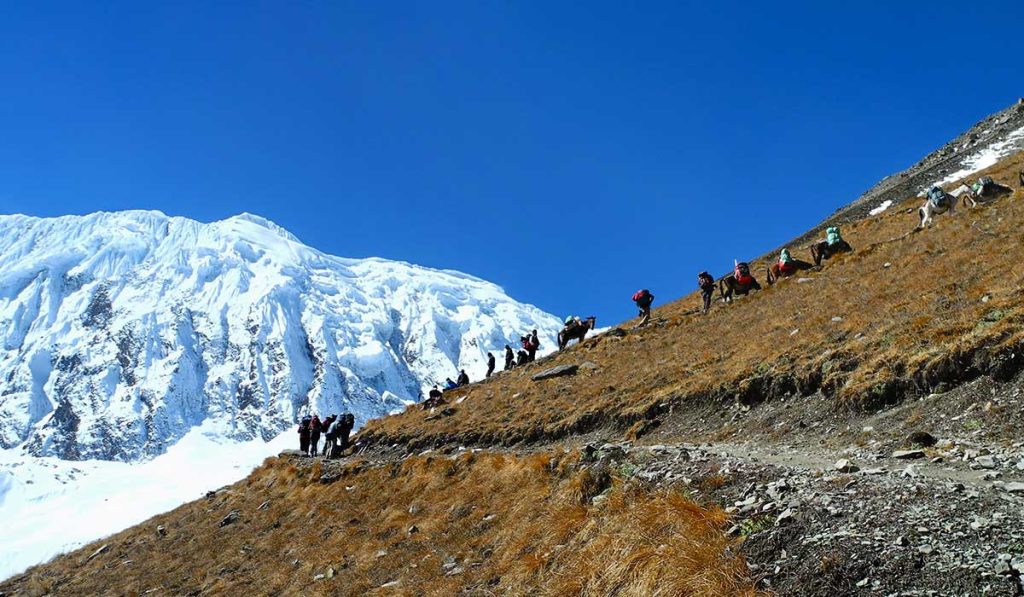
Choosing when to tackle the Annapurna Circuit is a bit like picking the right wine for dinner — it can elevate the whole experience or leave you wishing you’d gone another way.
Autumn gets all the hype for its stable weather and vibrant fall colors, but the case is unique for April. It’s springtime in the mountains and that means renewal in every sense.
After the long, snowy winter, the region starts to thaw. The temperatures rise just enough to make overall hiking a comfortable experience. And nature puts on a show that’s hard to beat. The air has this fresh, earthy scent from the melting snow and budding plants.
The following factors make April a perfect time for the Annapurna Circuit Trek.
Weather Benefits
Firstly, the weather is a significant advantage. You are looking at mostly sunny days with temperatures that don’t swing too wildly. In the lower elevations, it can feel almost balmy, pushing 15°C to 25°C during the day. The nights cool down without freezing you out. Up higher,
it’s chillier, but nothing like the sub-zero blasts you might experience in March. Clear skies are the norm. This means those massive Himalayan views aren’t shrouded in clouds or haze.
You can wake up to mornings where the peaks seem so sharp and close you could reach out and touch them. This month is pure magic for photographers or anyone who simply wants to pause and take in the beauty.
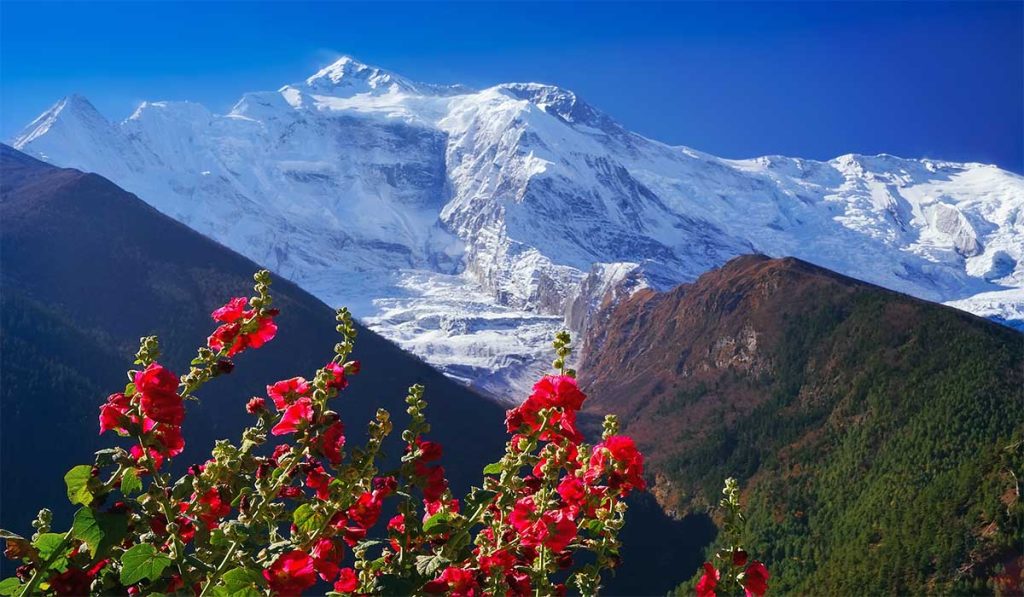
Vibrant Flora
Then there’s the flora. April is rhododendron season and if you have never seen these forests in bloom, you are in for a treat. Whole hillsides turn shades of pink, red and white, especially between Dharapani and Pisang. It’s like walking through a botanical garden on steroids, with orchids, primulas and other wildflowers joining the party.
Active Wildlife
Wildlife is more active and easier to see in April. You can see that birds are more active. And you might spot blue sheep or even a snow leopard if you’re incredibly lucky, though that’s rare, as it is an elusive animal.
Cultural Spectacle
Culturally, April syncs up with Baisakh Sankranti, the Nepali New Year. This falls usually on April 14. Villages along the trail light up with festivities. You can see traditional dances in colorful costumes, communal feasts where everyone shares rice beer and stories and a general vibe of optimism.
In places like Manang or Muktinath, you might stumble into a celebration that turns a rest day into something memorable.
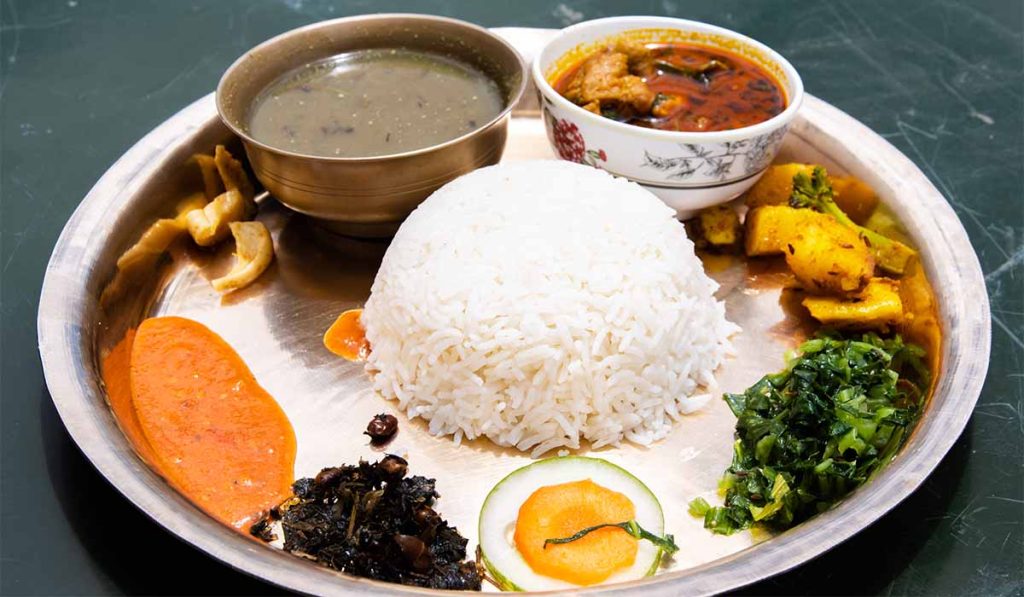
Vibrant Teahouses
Teahouses are fully stocked and open after winter closures. They serve up hearty meals like dal bhat or apple pie (yes, from local orchards) in April. And the crowds? It’s lively but without being chaotic. The April crowd has enough fellow trekkers so that you can make friends over evening tea. But there are not so many that you feel like you are in a tourist parade.
Some Challenges
Sure, there are minor downsides like occasional afternoon winds or a quick shower but they are manageable. Compared to May’s building humidity or March’s lingering snow risks, April feels balanced.
If you are after a trek where the mountains, culture and nature all align without extreme conditions throwing curveballs, this is your month. Once you have experienced spring during the April Annapurna Circuit Trek, you will wonder why more people don’t shout about it.
April Weather and Trail Conditions
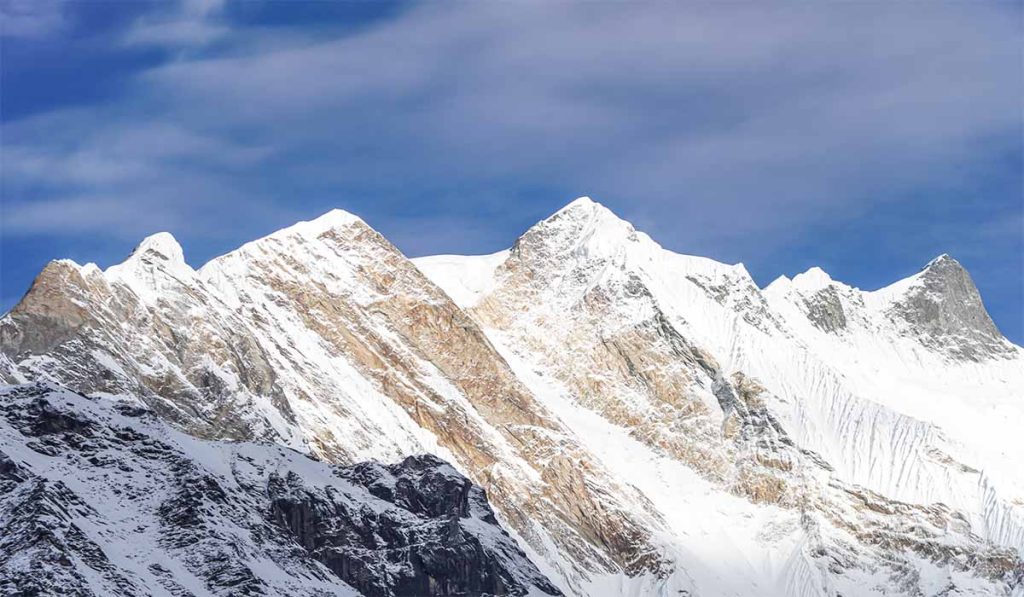
The weather in the Annapurna Circuit can be unpredictable. That is so because you are trekking through the Himalayas. But April is one of the best months to hit the trail.
Winter has loosened its grip, so snow has mostly melted, yet the summer monsoon hasn’t arrived. As such, the April Annapurna Circuit Trek gives trekkers generally stable and pleasant conditions. That said, altitude changes everything, so packing layers and rain gear is still essential.
Low Altitudes (Dharapani and below)
At low altitudes, below 2,000 meters, days are warm and inviting, usually 15°C to 25°C. They are perfect for shedding layers while trekking. Nights are cool but comfortable in April with temperatures ranging between 5°C and 15°C.
Snowmelt feeds the rivers in April and turns them into rushing torrents. As a result, the misty waterfalls beside the trail are a treat to the eyes. And paths are mostly dry, making for easy walking compared to wetter months.
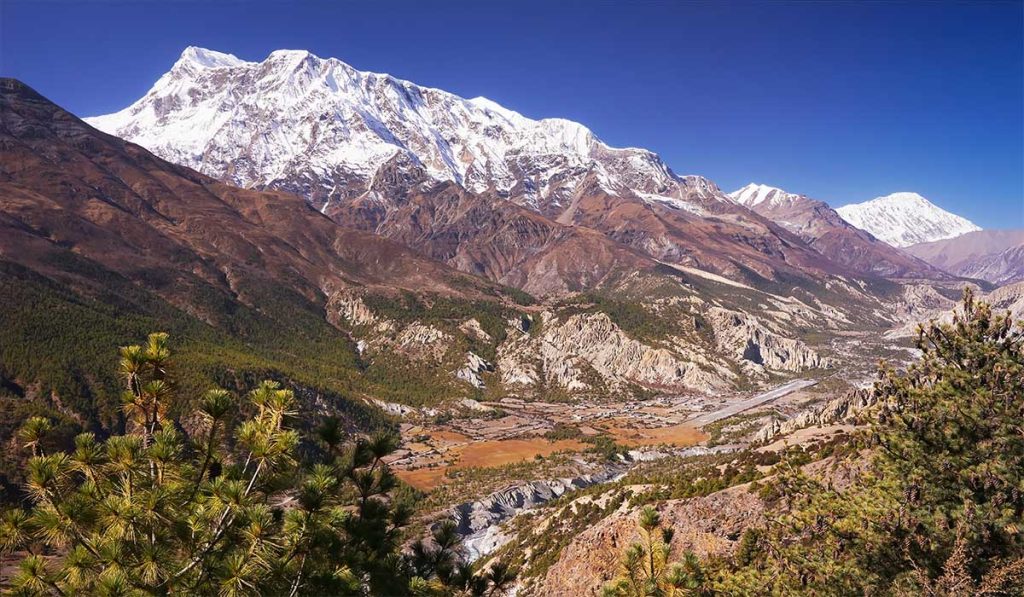
Mid-Altitudes (Chame to Manang)
At mid-altitudes, which range from 2,000 meters to 4,000 meters, temperatures cool down. The daytime averages 5°C to 20°C, with nights between 0°C and 10°C. Spring really shines here. Forests are green, wildflowers bloom along the paths and the air feels crisp and refreshing. Light afternoon showers can happen. But they are usually short-lived and the sun dries everything quickly. Compared to March, there is less snow blocking the trail. And unlike May, the humidity is low in April. This results in comfortable trek conditions when one needs to trek for long days on the trail.
High Altitudes (Yak Kharka to Thorong La)
The higher altitudes are colder even in April. Temperatures range from -5°C to 15°C during the day and drop to -10°C to 5°C or lower at night. Snow may linger in shaded areas or on the pass. But April’s stronger sun helps melt ice faster than in earlier months. Thus, this makes crossing the passes safer. Meanwhile, afternoon winds, especially after Thorong La toward Mustang, can be strong. So one should opt for early starts to avoid the wind.
Overall, April offers some of the best trail conditions of the year — less icy than winter and drier than the pre-monsoon months. Still, keep an eye on forecasts, use weather apps or check with local guides to stay ahead of any surprises.
Route and Itinerary Highlights for April
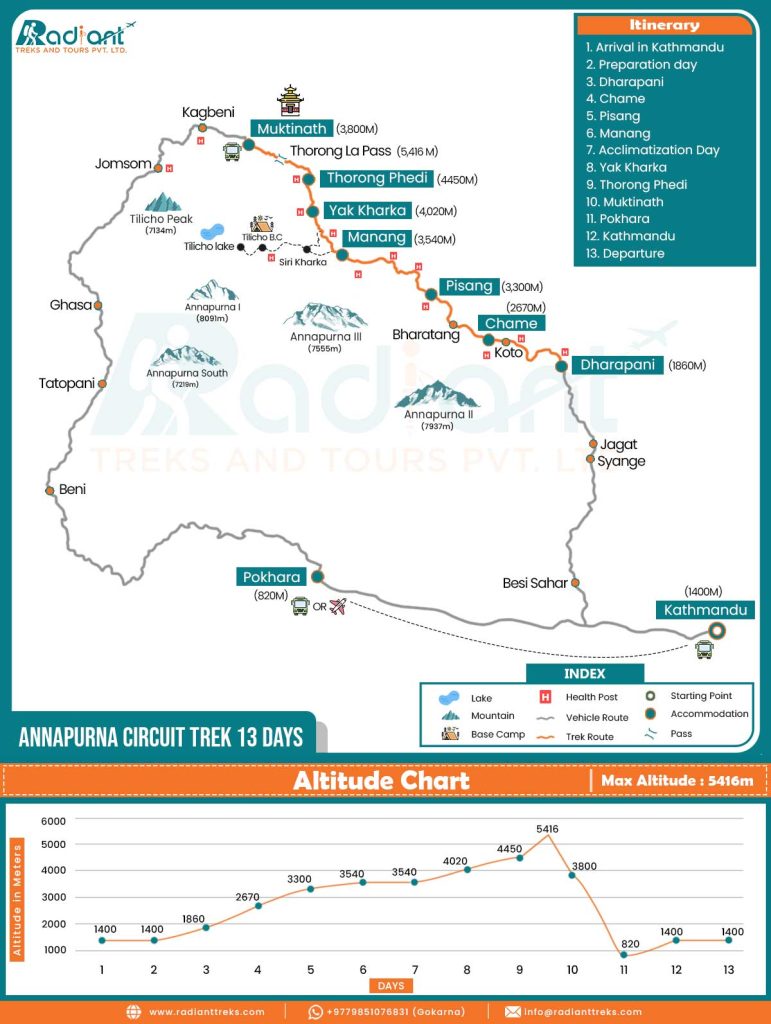
This itinerary streamlines the classic Annapurna Circuit Trek while keeping all the unforgettable moments of April intact. It focuses on your trekking journey that begins from Dharapani to Muktinath. And there are options to use drives to bypass long, less scenic road sections. The total trek is roughly 160 to 230 km, with gradual elevation gains that make acclimatization manageable.
April is arguably the best time to do this trek. Spring breathes life into the mountains. Rhododendrons and wildflowers bloom along trails and clear skies frame Annapurna I, Dhaulagiri and the surrounding peaks. The villages along the trekking trail are back to life after the quiet of winter. The weather is comfortable and suitable for trekking.
Here are some highlights of the route and itinerary:
Kathmandu to Dharapani / Besisahar
Start with a scenic drive through green lowlands and terraced fields that seem awakened with the arrival of spring. Rivers swell from snowmelt and create waterfalls along the way. April’s mild weather, where temperatures range between 15°C and 25°C, makes the journey comfortable as well as photogenic.
Dharapani to Chame
The trail climbs through pine forests and orchards. Early rhododendrons start to bloom. Add to that the view of Annapurna II that dominates the skyline. Villages like Chame offer hot springs and cozy tea houses where trekkers can enjoy local butter tea during their Annapurna Circuit Trek in April.
Chame to Pisang
Dramatic cliffs and rock faces frame this stretch. Clear April skies provide unbeatable views of Pisang Peak. In addition, prayer flags flutter in gentle spring breezes. The upper village monastery is a cultural highlight.
Pisang to Manang
Higher paths provide panoramic vistas over juniper forests and alpine meadows. April flowers carpet the meadows, glaciers glisten in the sun and Manang’s small-town charm offers bakeries, gear shops and traditional food stops to the trekkers.
Manang and Surroundings
Usually, on the seventh day, you take a rest for acclimatization in Manang during your Annapurna Circuit Trek in April. Spring brings active wildlife — Himalayan tahr, monkeys, and colorful birds. During your hike to Gangapurna Lake or Ice Lake on a spring day, do not miss enjoying them reflecting the snowy peaks. These lakes offer opportunities for springtime photography for photo enthusiasts. If you are trekking in the middle of April, you get a chance to experience Nepali New Year celebrations.
Manang to Thorong Phedi
This section of your journey requires gradual climbs to high-altitude pastures. Here, snow patches from winter remain. Yet they are safer in April as compared to March due to the warmer sun. Early starts avoid afternoon winds and clear skies provide panoramic views of Thorong La Pass and surrounding peaks.
Thorong La Pass to Muktinath
You need to cross the highest point (5,416 m) of the trek with spring sunshine softening icy sections. Descending to the sacred Muktinath Temple, you can enjoy the views enhanced by clear spring weather. This further makes your experience of 108 holy spouts and spiritual rituals memorable.
Muktinath to Kathmandu
Optional drives or flights offer a scenic return from Muktinath to Kathmandu as one passes through Mustang’s moonscape. In April, lakeside Pokhara is warm and inviting, perfect for relaxing after high-altitude trekking.
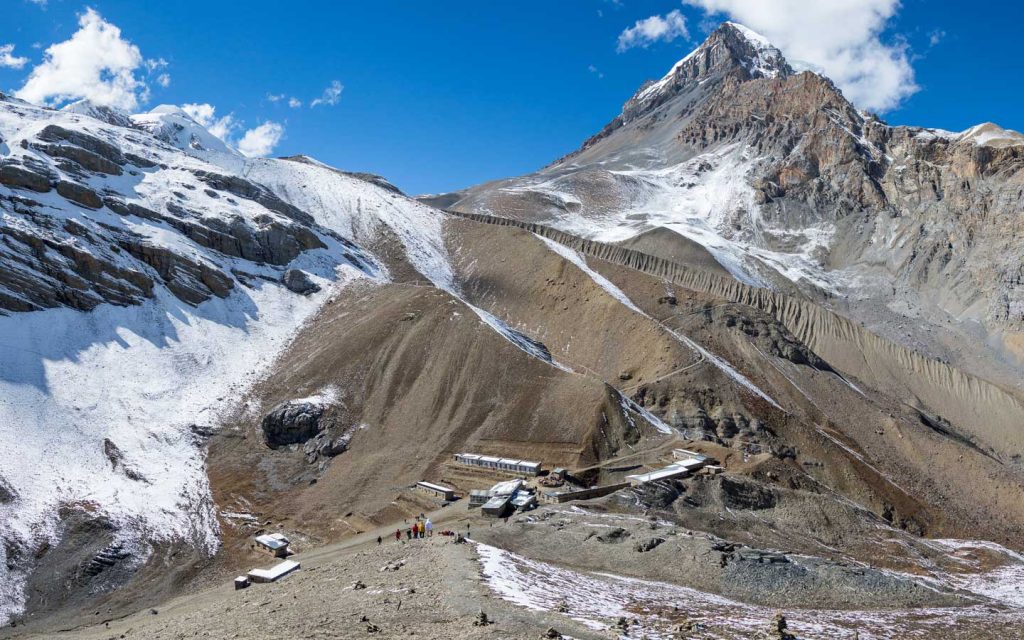
Outline Itinerary of Annapurna Circuit Trek in April
- Day 1: Arrival in Kathmandu
- Day 2: Preparation for Trek in Kathmandu
- Day 3: Drive from Kathmandu to Dharapani (1,860 m / 6,102 ft), Distance: 393.4 km / 245 miles, Duration: 7 to 8 hours
- Day 4: Trek to Chame from Dharapani (2,670 m / 8,759 ft), Distance: 15.7 km / 9.8 miles, Duration: 5 to 6 hours
- Day 5: Trek to Pisang from Chame (3,300 m / 10,826.77 ft), Distance: 13.7 km / 8.5 miles, Duration: 5 to 6 hours
- Day 6: Trek to Manang from Pisang ( 3,540 m /11,614.17 ft), Distance: 17.2 km / 11 miles, Duration: 5 to 6 hours
- Day 7: Acclimatization Day in Manang
- Day 8: Trek to Yak Kharka from Manang (4,020 m / 13,188 ft), Distance: 10.4 km / 6.5 miles, Duration: 4 to 5 hours
- Day 9: Trek to Thorong Phedi from Yak Kharka (4,450 m / 14,599 ft), Distance 7.3 km / 4.5 miles, Duration 4 to 5 hours
- Day 10: Trek from Throng Phedi to Muktinath (3,800 m / 12,487 ft) via Thorong La Pass (5,416m / 17,769 ft), Distance: 16.4 km / 10 miles, Duration: 7 to 8 hours
- Day 11: Visit Muktinath Temple in the Early Morning and Drive to Pokhara (822 m / 2,696 ft), Distance: 174 km / 109 miles, Duration: 7 to 8 hours
- Day 12: Pokhara to Kathmandu ( Fly or Drive)
- Day 13: Departure from Kathmandu
Handling Challenges of April Annapurna Circuit Trek
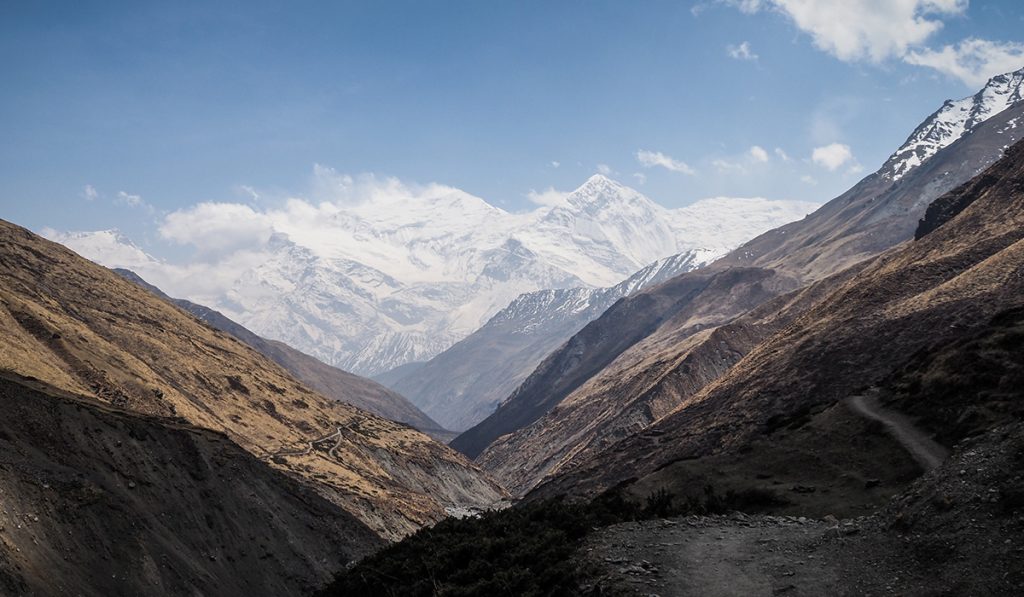
Every trek has its ups and downs and the Annapurna Circuit Trek in April is no exception. While the season is one of the best times to be on the trail, you’ll still face a few challenges along the way. The key is to know what’s coming and be ready for it. That way, these difficult moments become part of the adventure.
Altitude Sickness
First of all, altitude sickness is the big one in the Annapurna Circuit Trek in April. Once you cross 3,000 meters, around Pisang or Manang, your body starts noticing the thinner air. Headaches, dizziness or nausea can creep in. And if these symptoms are ignored, they can derail your trek.
The key is pacing yourself. The itinerary builds in a rest day at Manang at 3,540 meters for a reason. Use it to acclimatize with short hikes to Gangapurna Lake, among others, to let your body adjust.
Hydrate like it’s your job and aim for drinking at least 3 to 4 liters of water daily, as the dry mountain air sucks moisture out of you fast. Some trekkers swear by Diamox (acetazolamide) to ease symptoms, but talk to a doctor first. If you feel off, don’t push through. Instead, rest or descend slightly. The Himalayan Rescue Association clinic in Manang offers free advice. You can also drop in for a quick check.
Weather challenges
April’s weather, while generally kind, can throw curveballs. Afternoon winds, especially in the higher, open areas like Yak Kharka or post-Thorong La in Mustang, can be chilling even on sunny days. The fix? Hit the trail by 7:00 AM to enjoy calm mornings and those golden sunrise views.
Also, pack layered clothes and use them as per the need. Occasional spring showers can also make the paths slippery. It is particularly so in the forested mid-altitudes. There is nothing torrential like the monsoon, but a quick drizzle can make rocks slippery. So, invest in sturdy and grippy boots as they are lifesavers.
Trek Gear
Thorong La Pass is the trek’s pinnacle, but it’s no walk in the park. In April, lingering snow from winter might still dust the trail, especially on the ascent from Thorong Phedi. It’s not an ice wall, but icy patches can be treacherous without traction. Without proper gear, there are chances of you slipping during the hike. But do not be that person during your Annapurna Circuit trek in April.
Microspikes or crampons, which are rentable in Kathmandu for cheap, give you grip and confidence. Check conditions with your guide or at tea houses in Thorong Phedi. Locals always know the latest updates. Start this day before dawn to avoid softening snow as the sun climbs.
Sun Protection
The sun itself is another challenge during the Annapurna Circuit Trek in April. At high altitudes, UV rays are brutal and April’s clear skies amplify them. If you do not want those lobster-red faces due to sunburn, slather on SPF 50+ every morning, reapply midday. Also, wear a wide-brimmed hat or buff.
Likewise, sunglasses aren’t just for style. They protect your eyes from glare off snow or rocks. The role of hydration ties in here, too. The dry air can dehydrate you before you realize it. Carry a water bottle or hydration bladder and sip constantly.
Become an Early Bird
Finally, while April’s crowds are lighter than October’s, popular stops like Manang or Muktinath can get busy. That is true especially around tea houses at night. It’s not a deal-breaker, but arriving late might mean slim pickings for rooms.
Book ahead where possible and guides can help in this endeavor. Or aim to reach lodges by early afternoon. If you are flexible, quieter villages like Upper Pisang offer a peaceful vibe. These challenges sound daunting, but they are manageable with a bit of foresight.
Preparing for April Annapurna Circuit Trek

Getting ready for the Annapurna Circuit Trek in April is thrilling but demands attention to detail. From training your body to packing smart, here’s how to set yourself up for success in relation to April’s unique conditions.
Train your body
Start with your body. The circuit’s no stroll in the park. So, expect 5 to 8 hours of walking every day, often climbing steep trails or navigating uneven paths at high altitude.
To deal with these situations, kick off a training plan about 4 to 6 weeks before the trek. Focus on cardio: Jogging, cycling or stair-climbing. These exercises build stamina for long days. You can hike to local hills with a 10 to 15 kg backpack in order to mimic the real trek conditions. It is a game-changer for leg strength.
Core exercises like planks help with balance on rocky stretches. And do not skip stretching. Your calves will thank you after Thorong La.
If you are not a regular hiker, start with shorter walks and build up. By the time you are heading to Yak Kharka, you will be glad you didn’t skip those sessions.
Packing for April Trek
Packing is an art, and April calls for versatility. The weather shifts from warm valley days to freezing nights in altitudes above 4,000 m. So, pack your essentials accordingly while keeping in mind that layers are your best friend.
- Start with a moisture-wicking merino wool base layer— it keeps you dry and doesn’t stink after days of sweat.
- Add a mid-weight fleece for chilly mornings and top it with a packable down jacket for high altitudes.
- A waterproof, breathable shell, including jacket and pants, handles sudden showers or wind gusts.
- Convertible pants, comprising a zip-off to shorts, are practical for temperature shifts.
- Do not forget a warm hat, gloves and a buff for neck and face protection.
- Footwear is critical. Thus, invest in waterproof, broken-in trekking boots with good ankle support.
- Pack lightweight camp shoes or sandals for evenings — your feet will crave the break.
- Gear-wise, a sleeping bag rated to -5°C is a must; April nights get cold above Manang.
- A silk liner adds warmth and keeps things hygienic in tea houses.
- Trekking poles save your knees from injury during descents, especially when you trek down from Thorong La Pass.
- A headlamp with extra batteries is non-negotiable for the pass climb that you start before dawn.
- For hydration, a 2-liter bladder or bottle plus a purifier (tablets or a filter) ensures safe drinking water.
- Your health kit should include blister bandages, ibuprofen, antiseptic wipes as well as altitude medicines like Diamox. But consult a doctor first, as this medicine is not for everyone.
- Snacks like energy bars or nuts keep you fueled between meals. If snow’s reported on the pass, grab microspikes in Kathmandu; they’re cheap and effective.
Logistics
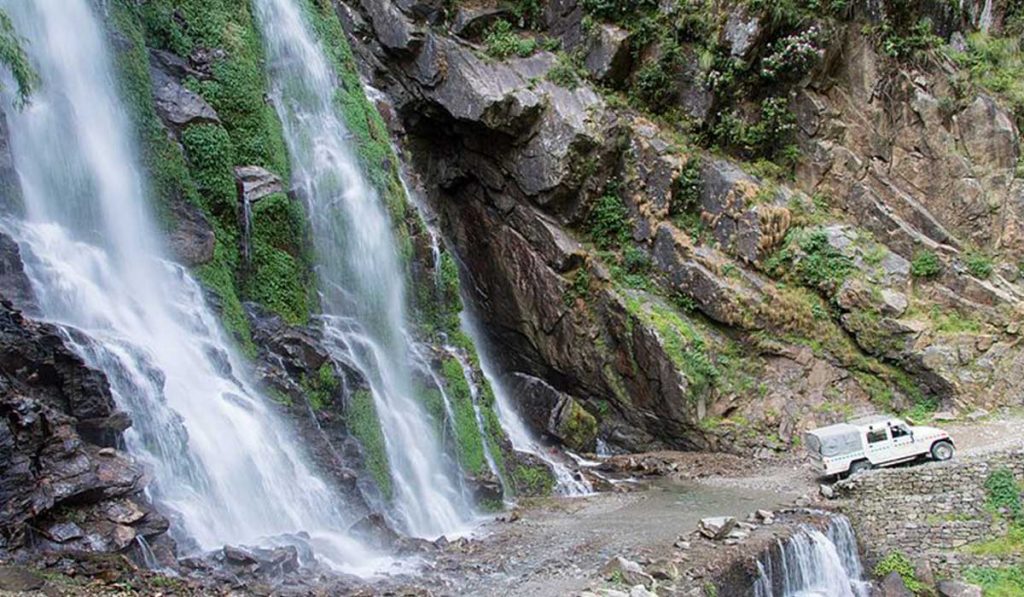
It is one of the factors that can’t be overlooked during the Annapurna Circuit Trek in April. You will need the Annapurna Conservation Area Permit.
Likewise, book transport early. Jeeps to Dharapani or flights from Jomsom can fill up.
Trekking with a guide in April is a smart call for first-timers. That is because they handle navigation, lodging and emergencies.
Porters lighten your load if you are not up for carrying 10 to 15 kg of luggage during the trek.
Insurance is critical. Thus, get a policy covering high-altitude trekking and emergency evacuation. Helicopter rescues cost thousands, so don’t skimp here.
Cultural Highlights
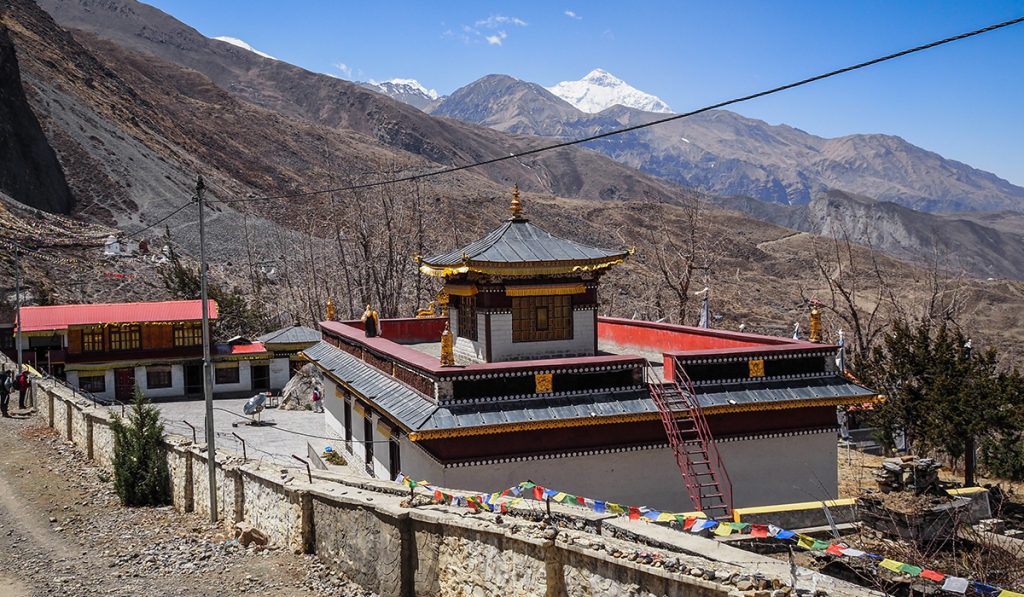
The April Annapurna Circuit isn’t only about mountains. It is also a journey into the cultural soul of Nepal. And you realize that in April, that soul feels especially alive. That is possible as spring breathes warmth into the villages through festivals, rituals and active everyday life.
Towards the middle of April, you witness Nepalis celebrating Baisakh Sankranti, the Nepali New Year. Villages like Manang and Chame become vibrant with gatherings, music and feasts. Meals are beyond simple dal bhat on this day. During the festivities, you will see plates overflowing with rice, lentils, spicy pickles and local rice beer.
Mingling with the locals, you come to the conclusion that it is not just food. But it is an invitation into the community’s heart and it is shared with laughter and song.
Further along, Muktinath is a cultural highlight. Perched beyond Thorong La Pass, its temple complex is sacred to both Hindus and Buddhists. The pilgrims bathe under the 108 spouts and pray before the eternal flame in this sacred site. As a trekker, you can witness those activities while trying to understand their significance.
Throughout the trek, the influence of Buddhism is evident in the form of mani walls carved with mantras, prayer wheels and colorful flags.
And the hospitality shines brighter than ever in April and that turns your trek into both a cultural and a natural adventure.
Practical Tips for Annapurna Circuit Trek in April
- Begin your trek as early as 6:30 AM to 7 AM to beat the afternoon winds in Mustang or near Thorong La. Doing so, you can enjoy calm mornings with golden peak views and secure better tea house spots.
- Fuel up smart by eating carb-heavy meals like dal bhat or thukpa. Add eggs or yak cheese for protein. Remember to carry nuts or dried fruit as snacks. But do not drink alcohol as it can affect your acclimatization process negatively.
- Reserve in busy spots like Manang or Thorong Phedi via guides. Arrive by early afternoon if you are trekking solo to avoid crowds and to get basic rooms. It is wise to book accommodations in advance.
- Carry cash during the trek as ATMs disappear past Pokhara. Small bills are always essential to pay in tea stops and remote teahouses as well as for giving tips.
- Use a reusable bottle or purifier to cut plastic waste. Pack out all trash to keep trails clean as your effort towards eco-friendly trekking.
- Drink sufficient water and the recommended amount is around 4 liters. That is to battle the dehydration caused by dry April air. Sip constantly to fend off altitude sickness and fatigue.
- Pack a first-aid kit that includes blister bandages, antiseptic and paracetamol. Consult a doctor if you want to use Diamox for altitude. Reapply SPF 50+ and wear UV sunglasses to protect yourself from the harmful impact of the sun.
- In Manang, take short acclimatization hikes as a step in preparing your body for Thorong La’s high altitude.
- Respect local culture and customs.
- Watch for symptoms of altitude sickness. Rest or descend if needed to stay safe and strong.
FAQs

Is April too crowded on the Annapurna Circuit?
Not at all — it’s a sweet spot. April sees more trekkers than winter’s quiet months, but it’s nowhere near the shoulder-to-shoulder rush of October or November. Places like Manang or Muktinath can feel lively, especially at popular tea houses in the evening, but it’s manageable. You will meet enough people to swap stories over a hot tea. To avoid competition for beds, arrive at lodges by mid-afternoon or book through a guide.
Is Thorong La Pass safe to cross in April?
Generally, yes, with the right preparation. At 5,416 meters, Thorong La is the trek’s toughest stretch and April’s conditions are friendlier than winter’s deep snow or summer’s muddy slush. Lingering snow patches are possible, but the spring sun melts them faster than in March, reducing risks. Check weather updates in Thorong Phedi — guides or lodge owners are helpful for this. Go with a group or guide for safety, start pre-dawn to avoid softening snow and carry microspikes for grip. If storms are forecast, delay a day. The pass isn’t forgiving in bad weather.
Do I need microspikes for April?
Often, yes. While April’s warmer temperatures clear much of the snow on Thorong La, icy patches can persist, especially in shaded spots. Microspikes — lightweight traction devices — are a cheap rental in Kathmandu and make the ascent safer. Ask about recent conditions in Manang or Thorong Phedi. If it’s been a dry spring, you might skip them, but better safe than sliding.
Is the trek suitable for beginners?
Absolutely, if you are reasonably fit and prepared. The circuit’s gradual elevation gain, with an acclimatization day in Manang, suits newcomers who have trained for 5 to 8 hours of hiking days. A 4 to 6 week regimen of cardio and hill walks is enough for most.
Should I go on a trek solo or guided?
Both work, but it depends on you. Solo trekking offers freedom and is feasible with good planning. But guides know shortcuts, secure lodges and spot altitude issues early. For April’s variable snow or weather, their local knowledge is invaluable, especially on Thorong La.







